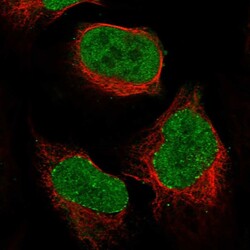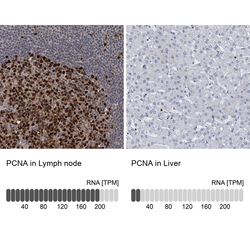Antibody data
- Antibody Data
- Antigen structure
- References [11]
- Comments [0]
- Validations
- Immunocytochemistry [1]
- Immunohistochemistry [1]
Submit
Validation data
Reference
Comment
Report error
- Product number
- HPA030522 - Provider product page

- Provider
- Atlas Antibodies
- Proper citation
- Atlas Antibodies Cat#HPA030522, RRID:AB_10602096
- Product name
- Anti-PCNA
- Antibody type
- Polyclonal
- Description
- Polyclonal Antibody against Human PCNA, Gene description: proliferating cell nuclear antigen, Validated applications: ICC, IHC, WB, Uniprot ID: P12004, Storage: Store at +4°C for short term storage. Long time storage is recommended at -20°C.
- Reactivity
- Human, Mouse, Rat
- Host
- Rabbit
- Conjugate
- Unconjugated
- Isotype
- IgG
- Vial size
- 100 µl
- Concentration
- 0.1 mg/ml
- Storage
- Store at +4°C for short term storage. Long time storage is recommended at -20°C.
- Handling
- The antibody solution should be gently mixed before use.
Submitted references Computer-aided engineering of stabilized fibroblast growth factor 21
Imaging-based study demonstrates how the DEK nanoscale distribution differentially correlates with epigenetic marks in a breast cancer model
Both Hypoxia-Inducible Factor 1 and MAPK Signaling Pathway Attenuate PI3K/AKT via Suppression of Reactive Oxygen Species in Human Pluripotent Stem Cells
Cyclin A2 localises in the cytoplasm at the S/G2 transition to activate PLK1
The oncoprotein DEK affects the outcome of PARP1/2 inhibition during mild replication stress
Loss of BRCA1 Spontaneously Induces the Tumorigenesis in Lacrimal Gland.
Inhibition of Estrogen Signaling Reduces the Incidence of BRCA1-associated Mammary Tumor Formation.
Diethylnitrosamine induces lung adenocarcinoma in FVB/N mouse.
EPIG-Seq: extracting patterns and identifying co-expressed genes from RNA-Seq data
Sulfonamide derivative targeting carbonic anhydrase IX as a nuclear imaging probe for colorectal cancer detectionin vivo
Human Glioblastoma Multiforme: p53 Reactivation by a Novel MDM2 Inhibitor
de La Bourdonnaye G, Ghazalova T, Fojtik P, Kutalkova K, Bednar D, Damborsky J, Rotrekl V, Stepankova V, Chaloupkova R
Computational and Structural Biotechnology Journal 2024;23
Computational and Structural Biotechnology Journal 2024;23
Imaging-based study demonstrates how the DEK nanoscale distribution differentially correlates with epigenetic marks in a breast cancer model
Pierzynska-Mach A, Cainero I, Oneto M, Ferrando-May E, Lanzanò L, Diaspro A
Scientific Reports 2023;13(1)
Scientific Reports 2023;13(1)
Both Hypoxia-Inducible Factor 1 and MAPK Signaling Pathway Attenuate PI3K/AKT via Suppression of Reactive Oxygen Species in Human Pluripotent Stem Cells
Fojtík P, Beckerová D, Holomková K, Šenfluk M, Rotrekl V
Frontiers in Cell and Developmental Biology 2021;8
Frontiers in Cell and Developmental Biology 2021;8
Cyclin A2 localises in the cytoplasm at the S/G2 transition to activate PLK1
Silva Cascales H, Burdova K, Middleton A, Kuzin V, Müllers E, Stoy H, Baranello L, Macurek L, Lindqvist A
Life Science Alliance 2021;4(3):e202000980
Life Science Alliance 2021;4(3):e202000980
The oncoprotein DEK affects the outcome of PARP1/2 inhibition during mild replication stress
Maiorano D, Ganz M, Vogel C, Czada C, Jörke V, Gwosch E, Kleiner R, Pierzynska-Mach A, Zanacchi F, Diaspro A, Kappes F, Bürkle A, Ferrando-May E
PLOS ONE 2019;14(8):e0213130
PLOS ONE 2019;14(8):e0213130
Loss of BRCA1 Spontaneously Induces the Tumorigenesis in Lacrimal Gland.
Kim SE, Baek HJ, Park EJ, Lim SC, Kim SS
Analytical cellular pathology (Amsterdam) 2018;2018:8120579
Analytical cellular pathology (Amsterdam) 2018;2018:8120579
Inhibition of Estrogen Signaling Reduces the Incidence of BRCA1-associated Mammary Tumor Formation.
Baek HJ, Kim SE, Choi EK, Kim JK, Shin DH, Park EJ, Kim TH, Kim JY, Kim KG, Deng CX, Kim SS
International journal of biological sciences 2018;14(12):1755-1768
International journal of biological sciences 2018;14(12):1755-1768
Diethylnitrosamine induces lung adenocarcinoma in FVB/N mouse.
Mervai Z, Egedi K, Kovalszky I, Baghy K
BMC cancer 2018 Feb 7;18(1):157
BMC cancer 2018 Feb 7;18(1):157
EPIG-Seq: extracting patterns and identifying co-expressed genes from RNA-Seq data
Li J, Bushel P
BMC Genomics 2016;17(1)
BMC Genomics 2016;17(1)
Sulfonamide derivative targeting carbonic anhydrase IX as a nuclear imaging probe for colorectal cancer detectionin vivo
Guan S, Cheng C, Ho A, Wang C, Luo T, Liao T, Chang J, Wu C, Liu S
Oncotarget 2015;6(34):36139-36155
Oncotarget 2015;6(34):36139-36155
Human Glioblastoma Multiforme: p53 Reactivation by a Novel MDM2 Inhibitor
Velasco G, Costa B, Bendinelli S, Gabelloni P, Da Pozzo E, Daniele S, Scatena F, Vanacore R, Campiglia P, Bertamino A, Gomez-Monterrey I, Sorriento D, Del Giudice C, Iaccarino G, Novellino E, Martini C
PLoS ONE 2013;8(8):e72281
PLoS ONE 2013;8(8):e72281
No comments: Submit comment
Supportive validation
- Submitted by
- Atlas Antibodies (provider)
- Main image

- Experimental details
- Immunofluorescent staining of human cell line U-2 OS shows localization to nuclear bodies.
- Sample type
- Human
Supportive validation
- Submitted by
- Atlas Antibodies (provider)
- Enhanced method
- Orthogonal validation
- Main image

- Experimental details
- Immunohistochemistry analysis in human lymph node and liver tissues using HPA030522 antibody. Corresponding PCNA RNA-seq data are presented for the same tissues.
- Sample type
- Human
- Protocol
- Protocol
 Explore
Explore Validate
Validate Learn
Learn Western blot
Western blot Immunocytochemistry
Immunocytochemistry